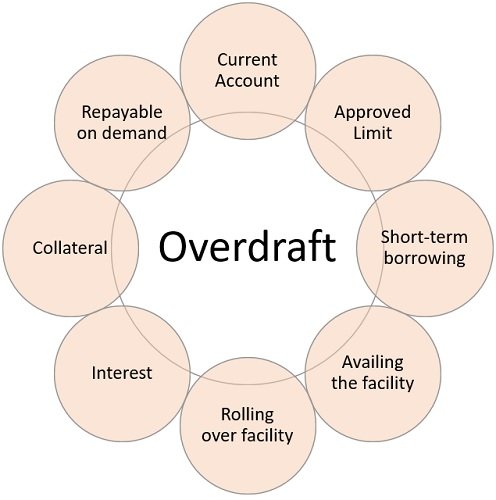Definition: Overdraft refers to open-ended financial assistance which the bank offers to the current account holders, in which the individuals and entities are allowed to withdraw funds from their accounts more than the amount standing in the credit of his/her current account or when the account has zero balance or even when the account shows debit (negative) balance.
Hence, it is a kind of loan which is provided by the banks, on which the current account holder is required to pay interest on the period for which the amount is borrowed, at a specified rate on the overdrawn amount. Further, the borrower can withdraw and repay the amount up to the agreed limit any number of times.
To avail this facility, the customer is required to make a written application to the bank regarding opening the current account with the bank. Further, at the discretion of the lending bank, the facility can be discontinued or modified.
Example
Suppose the balance in the customer’s account is ₹ 5,00,000 and the approved overdraft limit is ₹ 70,000. So, the customer can withdraw an amount up to ₹ 5,70,000.
Further, the approved overdraft limit is based on the relationship of each customer with the bank and their creditworthiness like financial stability, account balance, past history, etc. And so the money can be withdrawn up to that limit.
Salient Features of Overdraft
The salient features of overdraft are discussed hereunder:
- Current Account: Customers having a current account with the bank are provided a facility to draw more than the amount present in the credit of their account, such facility is known as an overdraft. Hence, all the rules applicable to the current account will apply to overdraft accounts.
- Approved Limit: Banks provide overdraft facilities over an approved predefined limit, which differs from customer to customer. And so a customer can withdraw money upto the maximum overdraft limit which the lending institution has sanctioned.
- Short-term borrowing: It is a form of short-term borrowing or borrowing for emergencies only. Thus it can reduce pressure on the working capital and it can be used as a resort to meet unexpected expenditures.
- Availing the facility: This facility is provided on the written application of the customer and signing a promissory note, which results in an express contract between the bank and the customer. However, in the absence of any express agreement between the lender and borrower, the agreement can be presumed from the course of business between the two parties.
- Rolling over facility: The limit is initially granted for one year and then rolled over once the bank reviews the utilization of the facility by the borrower.
- Interest: Interest is being charged on the actual amount overdrawn and not on the sanctioned limit. As well as it will be charged only for the period during which the amount is overdrawn.
- Collateral: To ensure the safety of the overdrawn amount, the overdraft is provided against security i.e. collateral security or personal security. In general, the collateral security may include – bank’s own deposits, surrender value of life insurance policies, government securities, cash incentive, financial instruments like approved shares and debentures, the unit value of mutual funds, etc.
- Repayable on demand: It is a revolving credit facility that is repayable on demand.
What is Temporary Overdraft?
If the customer requests and requires temporary overdrafts for small amounts, it will be allowed to the customer. A temporary overdraft facility is provided by the banks to the customers who are government employees with fixed income or businesspersons. These are unsecured overdrafts but granted only when some permanent source of funds is available to the borrower.
A Word from Business Jargons
Overdraft is a temporary accommodation granted against securities. A kind pre-approved loan, which is offered by the lending institutions to the customers having a current account, based on their creditworthiness. Using your overdraft facility means that you are increasing your debt. This facility can be utilized for fulfilling the working capital requirements of the business.

Leave a Reply